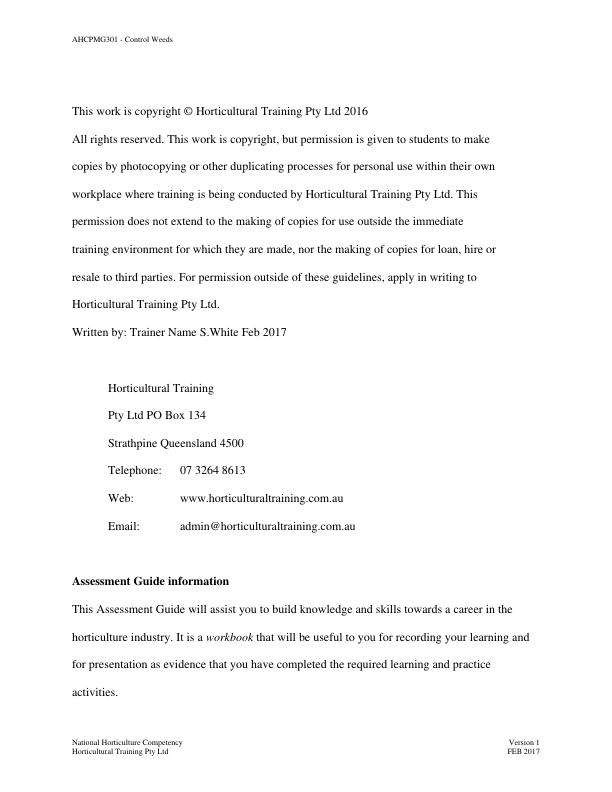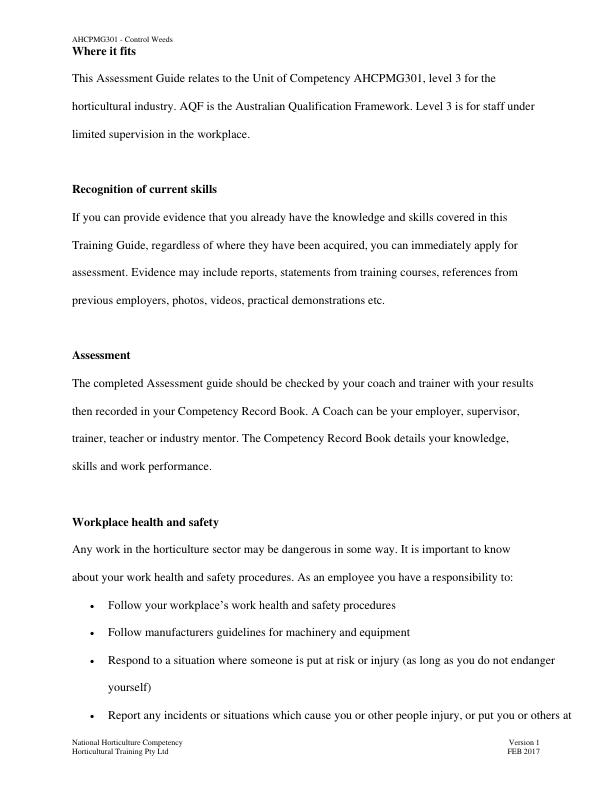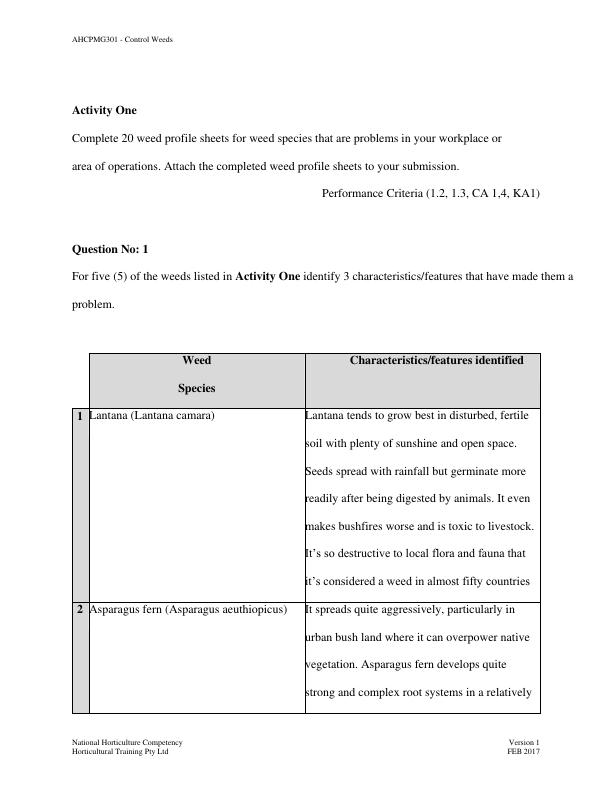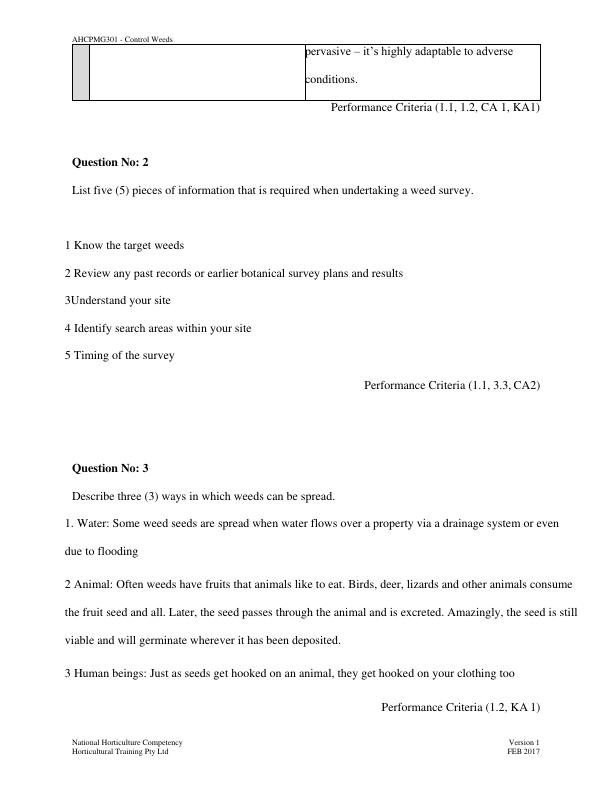Control Weeds - Assessment Guide
Added on 2023-04-21
34 Pages8767 Words361 Views
AHCPMG301
Control Weeds
Assessment Guide
Control Weeds
Assessment Guide

Questions assessed (please select) Orally - Written
Candidate Name:
Assessor Name:
Workplace/RTO:
Conditions:(e.g.
On
or off the
job)
I declare this is
all my own
work
Student signature
Date:
Candidate Name:
Assessor Name:
Workplace/RTO:
Conditions:(e.g.
On
or off the
job)
I declare this is
all my own
work
Student signature
Date:

AHCPMG301 - Control Weeds
National Horticulture Competency
Horticultural Training Pty Ltd
Version 1
FEB 2017
This work is copyright © Horticultural Training Pty Ltd 2016
All rights reserved. This work is copyright, but permission is given to students to make
copies by photocopying or other duplicating processes for personal use within their own
workplace where training is being conducted by Horticultural Training Pty Ltd. This
permission does not extend to the making of copies for use outside the immediate
training environment for which they are made, nor the making of copies for loan, hire or
resale to third parties. For permission outside of these guidelines, apply in writing to
Horticultural Training Pty Ltd.
Written by: Trainer Name S.White Feb 2017
Horticultural Training
Pty Ltd PO Box 134
Strathpine Queensland 4500
Telephone: 07 3264 8613
Web: www.horticulturaltraining.com.au
Email: admin@horticulturaltraining.com.au
Assessment Guide information
This Assessment Guide will assist you to build knowledge and skills towards a career in the
horticulture industry. It is a workbook that will be useful to you for recording your learning and
for presentation as evidence that you have completed the required learning and practice
activities.
National Horticulture Competency
Horticultural Training Pty Ltd
Version 1
FEB 2017
This work is copyright © Horticultural Training Pty Ltd 2016
All rights reserved. This work is copyright, but permission is given to students to make
copies by photocopying or other duplicating processes for personal use within their own
workplace where training is being conducted by Horticultural Training Pty Ltd. This
permission does not extend to the making of copies for use outside the immediate
training environment for which they are made, nor the making of copies for loan, hire or
resale to third parties. For permission outside of these guidelines, apply in writing to
Horticultural Training Pty Ltd.
Written by: Trainer Name S.White Feb 2017
Horticultural Training
Pty Ltd PO Box 134
Strathpine Queensland 4500
Telephone: 07 3264 8613
Web: www.horticulturaltraining.com.au
Email: admin@horticulturaltraining.com.au
Assessment Guide information
This Assessment Guide will assist you to build knowledge and skills towards a career in the
horticulture industry. It is a workbook that will be useful to you for recording your learning and
for presentation as evidence that you have completed the required learning and practice
activities.

AHCPMG301 - Control Weeds
National Horticulture Competency
Horticultural Training Pty Ltd
Version 1
FEB 2017
Where it fits
This Assessment Guide relates to the Unit of Competency AHCPMG301, level 3 for the
horticultural industry. AQF is the Australian Qualification Framework. Level 3 is for staff under
limited supervision in the workplace.
Recognition of current skills
If you can provide evidence that you already have the knowledge and skills covered in this
Training Guide, regardless of where they have been acquired, you can immediately apply for
assessment. Evidence may include reports, statements from training courses, references from
previous employers, photos, videos, practical demonstrations etc.
Assessment
The completed Assessment guide should be checked by your coach and trainer with your results
then recorded in your Competency Record Book. A Coach can be your employer, supervisor,
trainer, teacher or industry mentor. The Competency Record Book details your knowledge,
skills and work performance.
Workplace health and safety
Any work in the horticulture sector may be dangerous in some way. It is important to know
about your work health and safety procedures. As an employee you have a responsibility to:
Follow your workplace’s work health and safety procedures
Follow manufacturers guidelines for machinery and equipment
Respond to a situation where someone is put at risk or injury (as long as you do not endanger
yourself)
Report any incidents or situations which cause you or other people injury, or put you or others at
National Horticulture Competency
Horticultural Training Pty Ltd
Version 1
FEB 2017
Where it fits
This Assessment Guide relates to the Unit of Competency AHCPMG301, level 3 for the
horticultural industry. AQF is the Australian Qualification Framework. Level 3 is for staff under
limited supervision in the workplace.
Recognition of current skills
If you can provide evidence that you already have the knowledge and skills covered in this
Training Guide, regardless of where they have been acquired, you can immediately apply for
assessment. Evidence may include reports, statements from training courses, references from
previous employers, photos, videos, practical demonstrations etc.
Assessment
The completed Assessment guide should be checked by your coach and trainer with your results
then recorded in your Competency Record Book. A Coach can be your employer, supervisor,
trainer, teacher or industry mentor. The Competency Record Book details your knowledge,
skills and work performance.
Workplace health and safety
Any work in the horticulture sector may be dangerous in some way. It is important to know
about your work health and safety procedures. As an employee you have a responsibility to:
Follow your workplace’s work health and safety procedures
Follow manufacturers guidelines for machinery and equipment
Respond to a situation where someone is put at risk or injury (as long as you do not endanger
yourself)
Report any incidents or situations which cause you or other people injury, or put you or others at

AHCPMG301 - Control Weeds
National Horticulture Competency
Horticultural Training Pty Ltd
Version 1
FEB 2017
risk.
Equipment and materials to help you complete activities in this guide you will need access to the
following:
Personal protective clothing and equipment e.g. hat, safety boots, overalls, gloves,
spray suits, respiratory protection, apron
Sunscreen, Eye, face, respiratory protection, Hearing protection
Pesticide containers / labels / SDS.
Relevant spray equipment
Tape measure Measuring containers
Stop watch, Calculator
Materials required for monitoring biological agents
Notebook to record field notes and details of activity
Environmental Issues
It is important that you recognize your role in protecting the environment. As an employee you
have a responsibility to use the approved system of disposing of any hazardous materials after.
You should fully refer to the label and the organisation’s waste management policies. Pesticide
application may be harmful to the environment. Ensure you take all possible precautions to
minimize the effects on the environment.
National Horticulture Competency
Horticultural Training Pty Ltd
Version 1
FEB 2017
risk.
Equipment and materials to help you complete activities in this guide you will need access to the
following:
Personal protective clothing and equipment e.g. hat, safety boots, overalls, gloves,
spray suits, respiratory protection, apron
Sunscreen, Eye, face, respiratory protection, Hearing protection
Pesticide containers / labels / SDS.
Relevant spray equipment
Tape measure Measuring containers
Stop watch, Calculator
Materials required for monitoring biological agents
Notebook to record field notes and details of activity
Environmental Issues
It is important that you recognize your role in protecting the environment. As an employee you
have a responsibility to use the approved system of disposing of any hazardous materials after.
You should fully refer to the label and the organisation’s waste management policies. Pesticide
application may be harmful to the environment. Ensure you take all possible precautions to
minimize the effects on the environment.

AHCPMG301 - Control Weeds
National Horticulture Competency
Horticultural Training Pty Ltd
Version 1
FEB 2017
Activity One
Complete 20 weed profile sheets for weed species that are problems in your workplace or
area of operations. Attach the completed weed profile sheets to your submission.
Performance Criteria (1.2, 1.3, CA 1,4, KA1)
Question No: 1
For five (5) of the weeds listed in Activity One identify 3 characteristics/features that have made them a
problem.
Weed
Species
Characteristics/features identified
1 Lantana (Lantana camara) Lantana tends to grow best in disturbed, fertile
soil with plenty of sunshine and open space.
Seeds spread with rainfall but germinate more
readily after being digested by animals. It even
makes bushfires worse and is toxic to livestock.
It’s so destructive to local flora and fauna that
it’s considered a weed in almost fifty countries
2 Asparagus fern (Asparagus aeuthiopicus) It spreads quite aggressively, particularly in
urban bush land where it can overpower native
vegetation. Asparagus fern develops quite
strong and complex root systems in a relatively
National Horticulture Competency
Horticultural Training Pty Ltd
Version 1
FEB 2017
Activity One
Complete 20 weed profile sheets for weed species that are problems in your workplace or
area of operations. Attach the completed weed profile sheets to your submission.
Performance Criteria (1.2, 1.3, CA 1,4, KA1)
Question No: 1
For five (5) of the weeds listed in Activity One identify 3 characteristics/features that have made them a
problem.
Weed
Species
Characteristics/features identified
1 Lantana (Lantana camara) Lantana tends to grow best in disturbed, fertile
soil with plenty of sunshine and open space.
Seeds spread with rainfall but germinate more
readily after being digested by animals. It even
makes bushfires worse and is toxic to livestock.
It’s so destructive to local flora and fauna that
it’s considered a weed in almost fifty countries
2 Asparagus fern (Asparagus aeuthiopicus) It spreads quite aggressively, particularly in
urban bush land where it can overpower native
vegetation. Asparagus fern develops quite
strong and complex root systems in a relatively

AHCPMG301 - Control Weeds
National Horticulture Competency
Horticultural Training Pty Ltd
Version 1
FEB 2017
short time, which is what makes it such a tough
weed to tackle. Interestingly, what appear to be
leaves are actually small, flattened stems that
function in the same way as leaves
3 Bindii (Tribulus terrestris) It also grows small bright yellow flowers. Bindii
is also dangerous to livestock, as another plant
that can make them quite ill. It tends to grow
horizontally rather than vertically, but
underground its roots grow deep and secure. To
really get rid of Bindii, you’ll need to dig out the
entire root otherwise it’ll soon be back.
4
Prickly Pears (Opuntia spp.)
Prickly Pears are a succulent with cylindrical,
club-shaped or compressed stems that were
brought into Australia from the Americas to be
grown as a commercial crop as well as a
decorative plant. Prickly pears are a pest
because they present an injury hazard to humans
and animals, and can harbor pest animals such
as fruit fly and rabbits.
5 Fireweed (Senecio madagascariensis) Unsuspecting cows, horses and other livestock
who eat up this sneaky weed can get quite ill
and experience growth problems. In dry
conditions fireweed can be quite small with
narrow leaves, no branching, and few to no
flowers. This is the trick to what makes it so
National Horticulture Competency
Horticultural Training Pty Ltd
Version 1
FEB 2017
short time, which is what makes it such a tough
weed to tackle. Interestingly, what appear to be
leaves are actually small, flattened stems that
function in the same way as leaves
3 Bindii (Tribulus terrestris) It also grows small bright yellow flowers. Bindii
is also dangerous to livestock, as another plant
that can make them quite ill. It tends to grow
horizontally rather than vertically, but
underground its roots grow deep and secure. To
really get rid of Bindii, you’ll need to dig out the
entire root otherwise it’ll soon be back.
4
Prickly Pears (Opuntia spp.)
Prickly Pears are a succulent with cylindrical,
club-shaped or compressed stems that were
brought into Australia from the Americas to be
grown as a commercial crop as well as a
decorative plant. Prickly pears are a pest
because they present an injury hazard to humans
and animals, and can harbor pest animals such
as fruit fly and rabbits.
5 Fireweed (Senecio madagascariensis) Unsuspecting cows, horses and other livestock
who eat up this sneaky weed can get quite ill
and experience growth problems. In dry
conditions fireweed can be quite small with
narrow leaves, no branching, and few to no
flowers. This is the trick to what makes it so

AHCPMG301 - Control Weeds
National Horticulture Competency
Horticultural Training Pty Ltd
Version 1
FEB 2017
pervasive – it’s highly adaptable to adverse
conditions.
Performance Criteria (1.1, 1.2, CA 1, KA1)
Question No: 2
List five (5) pieces of information that is required when undertaking a weed survey.
1 Know the target weeds
2 Review any past records or earlier botanical survey plans and results
3Understand your site
4 Identify search areas within your site
5 Timing of the survey
Performance Criteria (1.1, 3.3, CA2)
Question No: 3
Describe three (3) ways in which weeds can be spread.
1. Water: Some weed seeds are spread when water flows over a property via a drainage system or even
due to flooding
2 Animal: Often weeds have fruits that animals like to eat. Birds, deer, lizards and other animals consume
the fruit seed and all. Later, the seed passes through the animal and is excreted. Amazingly, the seed is still
viable and will germinate wherever it has been deposited.
3 Human beings: Just as seeds get hooked on an animal, they get hooked on your clothing too
Performance Criteria (1.2, KA 1)
National Horticulture Competency
Horticultural Training Pty Ltd
Version 1
FEB 2017
pervasive – it’s highly adaptable to adverse
conditions.
Performance Criteria (1.1, 1.2, CA 1, KA1)
Question No: 2
List five (5) pieces of information that is required when undertaking a weed survey.
1 Know the target weeds
2 Review any past records or earlier botanical survey plans and results
3Understand your site
4 Identify search areas within your site
5 Timing of the survey
Performance Criteria (1.1, 3.3, CA2)
Question No: 3
Describe three (3) ways in which weeds can be spread.
1. Water: Some weed seeds are spread when water flows over a property via a drainage system or even
due to flooding
2 Animal: Often weeds have fruits that animals like to eat. Birds, deer, lizards and other animals consume
the fruit seed and all. Later, the seed passes through the animal and is excreted. Amazingly, the seed is still
viable and will germinate wherever it has been deposited.
3 Human beings: Just as seeds get hooked on an animal, they get hooked on your clothing too
Performance Criteria (1.2, KA 1)

End of preview
Want to access all the pages? Upload your documents or become a member.
Related Documents
AHCCHM303 Prepare and apply chemicalslg...
|34
|6714
|196
Transport and store chemicalslg...
|31
|6396
|264
Student Pack for BSBXDB501 Support staff members with disability in the workplacelg...
|89
|23510
|296
Developing workplace communication strategies Participant Workbook CHCCOM003 PW Moodle CHC51015 V1.0 CHCCOM003 Develop workplace communication strategies Participant Workbook CHCCOM003 PW Moodle CHC51lg...
|76
|11192
|92
HLTWHS002 Follow Safe Work Practices for Direct Client Care Assessment Workbooklg...
|38
|5637
|232
Designing and Implementing Service Programslg...
|12
|2115
|12
